What is the guarantee for the laid asphalt pavement of the road. Asphalt concrete pavement: what is it, what compositions are produced, manufacturing at home
Historians claim that the first mention of something similar to asphalt appeared in the 6th century BC in Babylon. But the technologies of those times were not reliable, plus unnecessarily expensive, as a result, such roads were forgotten until the twentieth century. The construction of asphalt concrete pavements in Russia began in 1928 and to this day it is predominant.
For this reason, the use of activated mineral powder increases the resistance of frost to cracking and asphaltene. Our limestone and limestone products are indispensable for engineers. road construction and contractors as they build roads and roads, airport runways and runways and other infrastructure around us.
Roads and dams to stabilize the soil. Lime is used to stabilize the soil during road construction, when soil moisture decreases. This method is impressive. Soil moisture not only decreases, but also improves the structure and increases the strength of the soil.
Photo of the laying of a country road.
What it is
This composition is used everywhere, starting from the laying of federal highways and ending with the arrangement of urban squares and garden paths in private construction.
According to GOST and SNiP device asphalt concrete pavement may be different.
But the overall composition of the mixture, for more than 100 years, remains unchanged:
Abroad, a very common and quite effective way. Currently, Lithuania is increasingly being used. The amount of lime added depends on soil moisture. For example, before starting to handle shopping centers or terminals, the primer is grounded, the foundation is ready, and the entire area is completely stabilized. This way you can refine all other structures.
When added to lime, the moisture content gives a foundation that is equivalent to low quality concrete. Powerful tractor with attached mills designed to stabilize the soil. This fully complies with the requirements for stabilization work.
- First of all, as an astringent, bitumen enters there..
- Surely, to one degree or another, sand and large mineral fillers are present.
- Various mineral or synthetic additives complete the list..
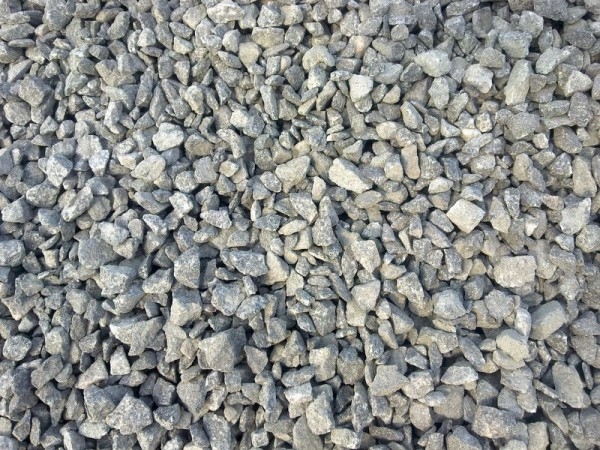
In those days when the composition was developed, natural bitumen was used, but since it is scarce in nature, an artificial analogue was synthesized based on oil products, which is still successfully used by road workers around the world.
The sand is taken quarry, as for the large filler, then, along with various types of crushed stone for concrete, crushed rock and some crystallized slag are widely used.
Natural mineral or synthetic additives are used to increase certain useful properties of the coating. In particular, it increases frost resistance, road adhesion, viscosity coefficient and much more.
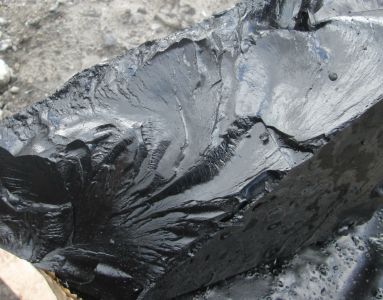
Bituminous resin.
What formulations are produced
The assortment of the presented types is quite wide, depending on the percentage ratio of the components, as well as on what additives were used, experts divide asphalt into the following varieties.

Fine grained asphalt.
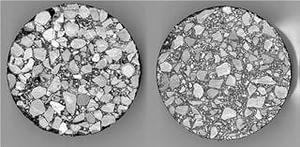
Slice coating.
Making asphalt at home
Manufacture pavement It is considered to be difficult and inaccessible. But, nevertheless, there are enthusiasts who are ready for experiments. Of course, such compositions are not designed for the federal highway, but in the country it is quite realistic to prepare such asphalt with your own hands.
Tip: from experience it can be said that a mixture prepared by a artisanal method, of course, is suitable for arranging a concrete garden path, but more often it is used to repair potholes on an already finished coating.

The temperature of the composition.
Classic recipe
For preparation, we need ordinary river or quarry sand, bitumen resin or bitumen, and fine gravel. Of the equipment you will need a metal barrel and a bucket.
It is better to cook asphalt at the stake, since it is unsafe and expensive to use gas.
- Initially, we pour crushed stone with sand in a ratio of 2: 1 and mix well. All this should be filled with water and suspended over a fire.
- At the same time, we are preparing a bitumen base. To do this, take a metal bucket and heat the bitumen in it to a boil, synthetic polymers can be added as a plasticizer, but it is cheaper to use shampoo or any detergent.
- When the resin has warmed up, and the water in the barrel with crushed stone has also boiled, they need to be combined. Water is needed so that crushed stone with sand does not heat up above 100ºС. Next, this broth should be stirred, maintaining a boil until all the water has boiled away. While the solution is hot it can be poured.
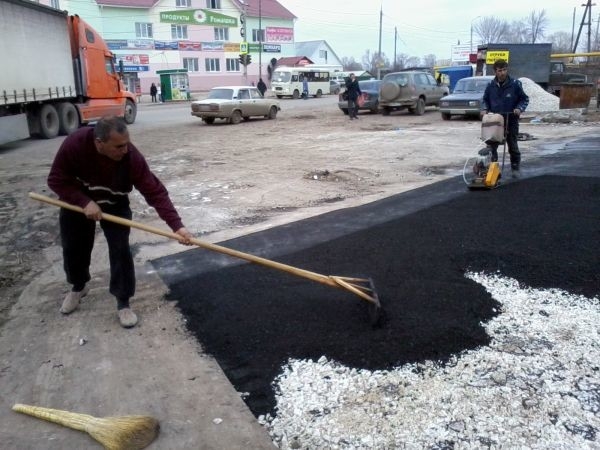
Manual styling.
Important: be careful, at 80 ºС bitumen melts, and at 100 - 120 ºС it boils.
But even at 170 ºС, bitumen can ignite.
Actually, in order to prevent such a fire, we use water.
Using old pavement
Dismantling of asphalt concrete pavements and bases can be a good material for the preparation of new asphalt.
The technology is somewhat reminiscent of the previous version, but with some amendments.
- The dismantling of asphalt concrete pavement itself is carried out by the old-fashioned method, using a sledgehammer and other percussion instruments. Only the top layer of asphalt connected with bitumen is used, you can not touch the travel pillow.
- The old road surface is broken into pieces with a fraction of not more than 40 mm. For 100 kg of old asphalt, 10 kg of bitumen is taken.
- After that, the crushed substance must be poured with water and boiled in a barrel until melted. Further, the technology repeats the above option. Heated bitumen combines with molten asphalt and water evaporates.
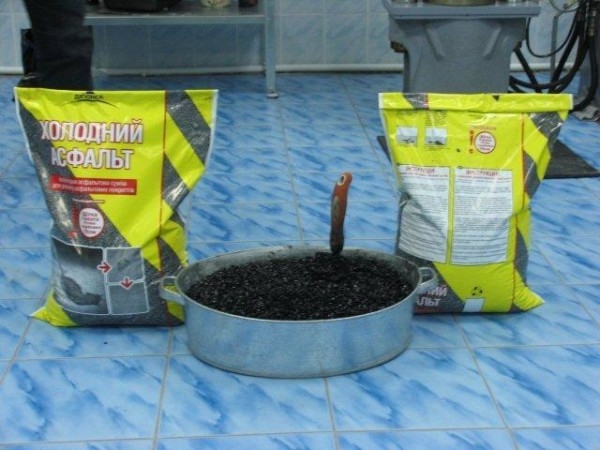
Cold asphalt.
The two methods described above are well suited for economical repair of damaged asphalt in the yard or near the yard. If you need to cover an area with a large quadrature, then we recommend using cold asphalt.
In the market of our country, this coating appeared about 5 years ago. The principle of operation here is similar to the well-known cold welding. For ligament used modified bitumenthanks to which it can be laid even at subzero temperatures. Instructions are on the packaging.

Manual vibratory rammer.
The only disadvantage of this material is the significant price. But, as you know, asphalt from the factory is released hot and must also be laid hot. Therefore, for remote locations, cold polymer asphalt is the only alternative.
Important: when repairing pavement, the problem is the quality of the joint seam in asphalt concrete pavement.
Cold asphalt based on polymers completely solves this problem, since it reliably fits with any composition based on bitumen.
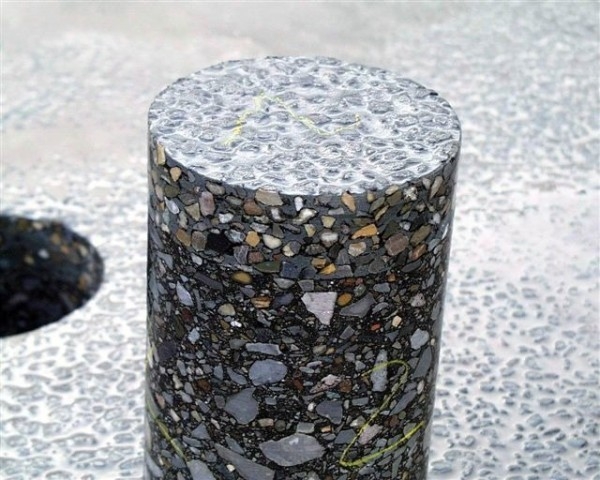
A slice of cold asphalt.
Rules for laying coatings
The construction of asphalt concrete pavement is a responsible matter and it will not be so important whether you lay it yourself or hire professionals. Laying and acceptance of asphalt concrete pavement is carried out according to SNiP 2.07.01-89, as well as a number of GOSTs.
Only a specialist can understand these documents; therefore, we have outlined the main provisions of these norms and rules in a more understandable language.
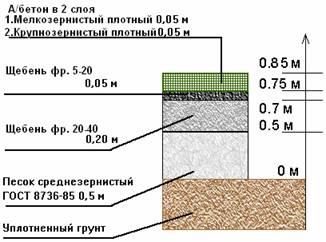
Laying scheme of roads with an average load.
Preparatory stage
Any work begins with markup. You need to clearly decide where the asphalt will be laid. Where the border will be mounted, and what it will be. It is also very important to make sure that the drainage, drainage system and drainage systems are fully installed.
All work on installing underground utilities by this time should be completely completed. If you are arranging a parking lot or access roads to an office, it is better to find out in advance where city communications are located, as if necessary, municipal services will tear off your coverage and may still be fined.
It was mentioned above about the varieties and purpose of existing types of asphalt. So, at the preparation stage, you need to choose what kind of material you are going to stack.
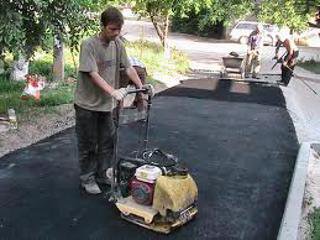
Work vibroplate.
Important: the estimate for the asphalt concrete paving device should contain not only data on the cost of the material and the amount of work.
It will be useful to include transportation costs in it, as well as leave the column for unforeseen expenses, such as permission to work from the relevant official or service.
If a pedestrian walkway or a platform with occasional passage of cars is laid, then a gravel-gravel pillow can be made up to 15 cm thick. The thickness of the asphalt concrete coating will be in the range of 4 - 5 cm.
If you equip a gas station or any access roads through which, with a high degree of probability, heavy machinery will occasionally pass, then in this case the thickness of the gravel pillow will be about 25 - 35 cm. Plus, asphalt itself is laid at least in 2 layers.
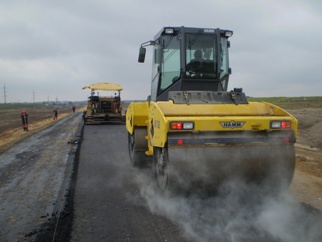
Heavy skating rink.
After marking, the arrangement of the so-called trough or pit under the road begins. In the urban area or in private construction, as a rule, roads and sites are made at approximately the same level, so the soil must be selected completely for the entire thickness of the “road cake”. Federal highways are equipped with a slightly different technology, but we will not dwell on it.
When the soil is selected, the entire site should be well compacted, this is done with a roller or vibrating plate. Pay attention to the presence of trees nearby, the roots may tear the asphalt over time, so it is best to remove them immediately if possible. Although the price of work will be slightly increased, we advise you to cover the soil with geotextiles so that the vegetation does not break through the coating.

Mobile installation for thermal profiling of asphalt.
Important: at this stage, borders are installed, they play the role of a kind of formwork for the "road cake".
If laying paving slabs the curb is made below the level of the road, then here, on the contrary.
In this regard, it is necessary to immediately plan the drains for water drainage.
Now you can begin to dump the pillows from crushed stone. For footpaths with a pillow thickness of 10 - 15 cm, 1 layer of crushed stone of a fraction of 30 - 40 mm is sufficient. More powerful bases fit into several layers.
The lower layer is used for drainage in the event of a rise in groundwater, it is sprinkled with large gravel with a fraction of 40 - 70 mm. The next layer with a fraction of 20 - 40 mm will be responsible for the even distribution of the load on the base of the road.
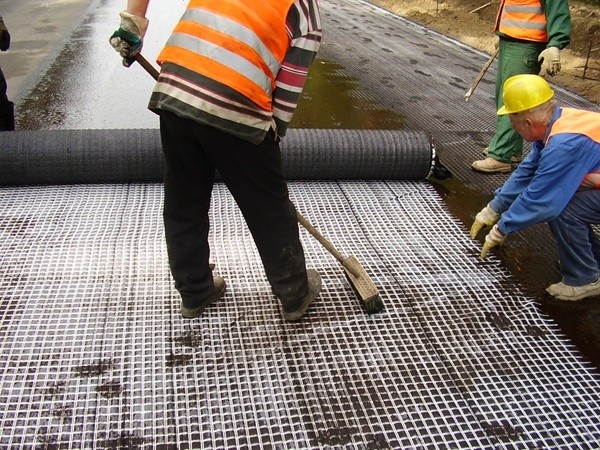
Road reinforcement with polymer mesh.
The final layer of filling is made of fine gravel with a fraction of 5 - 20 mm. He will also be responsible for the distribution of the load, but in addition he will turn the pillow into a dense, monolithic structure.
All layers laid must be tightly packed. For serious coatings, road rollers weighing from 2 to 10 tons are used. Each ball of filling is compacted separately, the skating rink must go through it at least 5 times, plus modern road skating rinks have a vibro press function, which increases the efficiency several times. During tamping, the surface should be watered regularly.
Tip: in the process of tamping, you must immediately take into account the angle of inclination of the road, on average it is on the order of 1º per 1 linear meter.
To do this, periodically check with the markup or level data.

Laying the federal highway.
Asphalt paving
After tamping the pillows, you can proceed directly to the laying of asphalt. As mentioned earlier, for sidewalks and adjoining territories, it is enough to lay a fine-grained composition with a layer of up to 50 mm. Heavy road rollers are also not required, you can get by with a light roller or vibrating plate.
Note!
This type of coating according to SNiP is not recommended for laying in places for rest.
More serious objects are paved in 2 layers. In this case, the lower layer is laid coarse asphalt at the level of 40 - 50 mm. A fine-grained composition is almost immediately applied to it, which in most cases is the final composition.
Currently, technologies have been developed according to which a reinforcing mesh made of polymer materials should be laid between the layers of hot asphalt. As a result, the durability and strength of such a road increases significantly. This technology is used when laying federal highways and roads with increased load.

Integrated road laying.
Important: the restoration of asphalt concrete pavement with us is most often done only with the help of hot bitumen.
Although according to GOST, thermal profiling of asphalt concrete coatings should be performed.
This procedure involves preheating roadbed to a depth of 2 - 5 cm.
The mixture must be delivered hot to the object, as a rule, it is brought by dump trucks with a carrying capacity of 7 to 20 tons. After that, asphalt is manually or mechanically distributed evenly along the road plane, observing the slope. On average, 1 ton of asphalt with a thickness of 40 mm is consumed per 10 m² of roadbed.
The construction of asphalt concrete pavements is a weather-dependent process. In the cold season, that is, at temperatures below +5 ºС, work is generally not recommended. Plus, during rain or wet weather, the styling quality is significantly reduced, since the composition is moistened and cools faster.

The unit for removing the old coating.
We have outlined the general basic principles of high-quality paving of asphalt, but science does not stand still and technologies are supplemented and improved. In the video in this article, you can consider the process of laying asphalt in more detail.
Historians claim that the first mention of something similar to asphalt appeared in the 6th century BC in Babylon. But the technologies of those times were not reliable, plus unnecessarily expensive, as a result, such roads were forgotten until the twentieth century. The construction of asphalt concrete pavements in Russia began in 1928 and to this day it is predominant.
What it is
This composition is used everywhere, starting from the laying of federal highways and ending with the arrangement of urban squares and garden paths in private construction.
According to GOST and SNiP, the device of asphalt concrete coating can be different.
But the overall composition of the mixture, for more than 100 years, remains unchanged:
- First of all, as an astringent, bitumen enters there..
- Surely, to one degree or another, sand and large mineral fillers are present.
- Various mineral or synthetic additives complete the list..
In those days when the composition was developed, natural bitumen was used, but since it is scarce in nature, an artificial analogue was synthesized based on oil products, which is still successfully used by road workers around the world.
The sand is taken quarry, as for the large filler, then along with various, crushed rock and some crystallized slag are widely used.
Natural mineral or synthetic additives are used to increase certain useful properties of the coating. In particular, it increases frost resistance, road adhesion, viscosity coefficient and much more.
What formulations are produced
The assortment of the presented types is quite wide, depending on the percentage ratio of the components, as well as on what additives were used, experts divide asphalt into the following varieties.
- For the arrangement of sidewalks, garden paths or the inner space of urban courtyards, sand compositions are used.
- Fine-grained compositions cover urban streets with medium and high traffic.
- Coarse-grained asphalt is used as a base layer in multi-layer paving technology.
- Bitumen polymer coatings are used in the installation of bridges, three-dimensional parking or road junctions. They have increased strength and durability.
- Crushed stone mastic types of asphalt are considered the strongest; they are laid by federal highways and high-speed autobahns with increased traffic load.
- For stadiums, treadmills or bicycle paths, as well as other sports facilities, there is a rubber-bitumen coating.
Making asphalt at home
The manufacture of pavement is considered to be difficult and inaccessible. But, nevertheless, there are enthusiasts who are ready for experiments. Of course, such compositions are not designed for the federal highway, but in the country it is quite realistic to prepare such asphalt with your own hands.
Tip: from experience it can be said that a mixture prepared by a makeshift method, of course, is suitable for arrangement, but more often it is used to repair potholes on an already finished coating.
Classic recipe
For preparation, we need ordinary river or quarry sand, bitumen resin or bitumen, and fine gravel. Of the equipment you will need a metal barrel and a bucket.
It is better to cook asphalt at the stake, since it is unsafe and expensive to use gas.
- Initially, we pour crushed stone with sand in a ratio of 2: 1 and mix well. All this should be filled with water and suspended over a fire.
- At the same time, we are preparing a bitumen base. To do this, take a metal bucket and heat the bitumen in it to a boil, synthetic polymers can be added as a plasticizer, but it is cheaper to use shampoo or any detergent.
- When the resin has warmed up, and the water in the barrel with crushed stone has also boiled, they need to be combined. Water is needed so that crushed stone with sand does not heat up above 100ºС. Next, this broth should be stirred, maintaining a boil until all the water has boiled away. While the solution is hot it can be poured.
Important: be careful, at 80 ºС bitumen melts, and at 100 - 120 ºС it boils.
But even at 170 ºС, bitumen can ignite.
Actually, in order to prevent such a fire, we use water.
Using old pavement
Dismantling of asphalt concrete pavements and bases can be a good material for the preparation of new asphalt.
The technology is somewhat reminiscent of the previous version, but with some amendments.
- The dismantling of asphalt concrete pavement itself is carried out by the old-fashioned method, using a sledgehammer and other percussion instruments. Only the top layer of asphalt connected with bitumen is used, you can not touch the travel pillow.
- The old road surface is broken into pieces with a fraction of not more than 40 mm. For 100 kg of old asphalt, 10 kg of bitumen is taken.
- After that, the crushed substance must be poured with water and boiled in a barrel until melted. Further, the technology repeats the above option. Heated bitumen combines with molten asphalt and water evaporates.
Cold asphalt
The two methods described above are well suited for economical repair of damaged asphalt in the yard or near the yard. If you need to cover an area with a large quadrature, then we recommend using cold asphalt.
In the market of our country, this coating appeared about 5 years ago. The principle of operation here is similar to the well-known cold welding. A modified bitumen is used for the bundle, so it can be stacked even at sub-zero temperatures. Instructions are on the packaging.
The only disadvantage of this material is the significant price. But, as you know, asphalt from the factory is released hot and must also be laid hot. Therefore, for remote locations, cold polymer asphalt is the only alternative.
Important: when repairing pavement, the problem is the quality of the joint seam in asphalt concrete pavement.
Cold asphalt based on polymers completely solves this problem, since it reliably fits with any composition based on bitumen.
Rules for laying coatings
The construction of asphalt concrete pavement is a responsible matter and it will not be so important whether you lay it yourself or hire professionals. Laying and acceptance of asphalt concrete pavement is carried out according to SNiP 2.07.01-89, as well as a number of GOSTs.
Only a specialist can understand these documents; therefore, we have outlined the main provisions of these norms and rules in a more understandable language.
Preparatory stage
Any work begins with markup. You need to clearly decide where the asphalt will be laid. Where the border will be mounted, and what it will be. It is also very important to make sure that the drainage, drainage system and drainage systems are fully installed.
All work on installing underground utilities by this time should be completely completed. If you are arranging a parking lot or access roads to an office, it is better to find out in advance where city communications are located, as if necessary, municipal services will tear off your coverage and may still be fined.
It was mentioned above about the varieties and purpose of existing types of asphalt. So, at the preparation stage, you need to choose what kind of material you are going to stack.
Important: the estimate for the asphalt concrete paving device should contain not only data on the cost of the material and the amount of work.
It will be useful to include transportation costs in it, as well as leave the column for unforeseen expenses, such as permission to work from the relevant official or service.
If a pedestrian walkway or a platform with occasional passage of cars is laid, then a gravel-gravel pillow can be made up to 15 cm thick. The thickness of the asphalt concrete coating will be in the range of 4 - 5 cm.
If you equip a gas station or any access roads through which, with a high degree of probability, heavy machinery will occasionally pass, then in this case the thickness of the gravel pillow will be about 25 - 35 cm. Plus, asphalt itself is laid at least in 2 layers.
After marking, the arrangement of the so-called trough or pit under the road begins. In the urban area or in private construction, as a rule, roads and sites are made at approximately the same level, so the soil must be selected completely for the entire thickness of the “road cake”. Federal highways are equipped with a slightly different technology, but we will not dwell on it.
When the soil is selected, the entire site should be well compacted, this is done with a roller or vibrating plate. Pay attention to the presence of trees nearby, the roots may tear the asphalt over time, so it is best to remove them immediately if possible. Although the price of work will be slightly increased, we advise you to cover the soil with geotextiles so that the vegetation does not break through the coating.
Important: at this stage, borders are installed, they play the role of a kind of formwork for the "road cake".
If when laying paving slabs the curb is made below the level of the road, then here, on the contrary.
In this regard, it is necessary to immediately plan the drains for water drainage.
Now you can begin to dump the pillows from crushed stone. For footpaths with a pillow thickness of 10 - 15 cm, 1 layer of crushed stone of a fraction of 30 - 40 mm is sufficient. More powerful bases fit into several layers.
The lower layer is used for drainage in the event of a rise in groundwater, it is sprinkled with large gravel with a fraction of 40 - 70 mm. The next layer with a fraction of 20 - 40 mm will be responsible for the even distribution of the load on the base of the road.
The final layer of filling is made of fine gravel with a fraction of 5 - 20 mm. He will also be responsible for the distribution of the load, but in addition he will turn the pillow into a dense, monolithic structure.
All layers laid must be tightly packed. For serious coatings, road rollers weighing from 2 to 10 tons are used. Each ball of filling is compacted separately, the skating rink must go through it at least 5 times, plus modern road skating rinks have a vibro press function, which increases the efficiency several times. During tamping, the surface should be watered regularly.
Tip: in the process of tamping, you must immediately take into account the angle of inclination of the road, on average it is on the order of 1º per 1 linear meter.
To do this, periodically check with the markup or level data.
Asphalt paving
After tamping the pillows, you can proceed directly to the laying of asphalt. As mentioned earlier, for sidewalks and adjoining territories, it is enough to lay a fine-grained composition with a layer of up to 50 mm. Heavy road rollers are also not required, you can get by with a light roller or vibrating plate.
Note!
This type of coating according to SNiP is not recommended for laying in places for rest.
More serious objects are paved in 2 layers. In this case, the lower layer is laid with coarse asphalt at a level of 40 - 50 mm. A fine-grained composition is almost immediately applied to it, which in most cases is the final composition.
Currently, technologies have been developed according to which a reinforcing mesh made of polymer materials should be laid between the layers of hot asphalt. As a result, the durability and strength of such a road increases significantly. This technology is used when laying federal highways and roads with increased load.
Although according to GOST, thermal profiling of asphalt concrete coatings should be performed.
This procedure provides for the preliminary warming of the roadway to a depth of 2 - 5 cm.
The mixture must be delivered hot to the object, as a rule, it is brought by dump trucks with a carrying capacity of 7 to 20 tons. After that, asphalt is manually or mechanically distributed evenly along the road plane, observing the slope. On average, 1 ton of asphalt with a thickness of 40 mm is consumed per 10 m² of roadbed.
The construction of asphalt concrete pavements is a weather-dependent process. In the cold season, that is, at temperatures below +5 ºС, work is generally not recommended. Plus, during rain or wet weather, the styling quality is significantly reduced, since the composition is moistened and cools faster.
Conclusion
We have outlined the general basic principles of high-quality paving of asphalt, but science does not stand still and technologies are supplemented and improved. In the video in this article, you can consider the process of laying asphalt in more detail.




